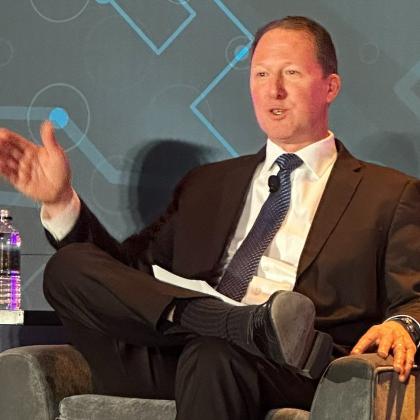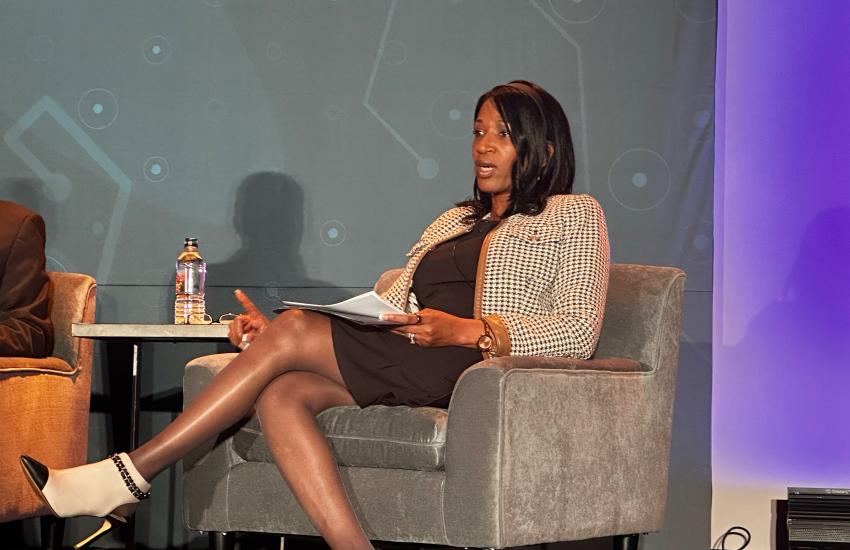Tabletop Exercises Aren’t Just for Warfare, They Are Also for Workforce Development
The U.S. Department of Defense’s (DoD’s) workforce is short 30,000 cyber and information technology (IT) personnel. And the rest of the department’s workforce needs to be managed adroitly for the United States to compete and win in Great Power Competition with China, explained Mark Gorak, principal director, Resources and Analysis, DoD Office of the Chief Information Officer; Brynt Parmeter, chief talent management officer, DoD; and Venice Goodwine, Department of the Air Force’s new chief information officer (CIO), speaking on a panel moderated by Goodwine at the AFCEA Rocky Mountain Cyberspace Symposium in Colorado Springs, Colorado, on February 21.
The U.S. Air Force is pursuing similar workforce actions to the greater DoD as it repositions itself to face China, Goodwine said. “Most of you have seen the announcements made by the secretary of the Air Force and the senior leaders around really optimizing for Great Power Competition, and a big part of that is a focus on people,” she noted.
The new Air Force CIO emphasized how Parmeter was the DoD’s first chief talent management officer, put in place last April to help develop the military’s workforce—cyber and otherwise. Parmeter, a West Point graduate and Army veteran who most recently worked for Walmart as a talent management executive, is rolling out DoD’s Labor Management Framework (LMF).
The LMF relies on a “broader market approach,” managing supply and demand of workers and “building a pipeline of talent through a whole-of-government and whole-of action” effort. The intent, Parmeter said, is to create better user experiences throughout the whole employment life cycle. And to build its workforce, the DoD will identify talent pools, engage partners, train and employ talent, among other efforts.
“I think it's going to bear fruit for the DoD in multiple functional communities, in particular for the cyber functional community,” Parmeter noted. “And we can look at the functional communities that crosscut between the services and the components, whether it's active, Guard, Reserve or civilian. We can think and act and understand who we are, what our brand is, what we need, what are the knowledge, skills, attributes and competencies, and then plug that over to the supply side of the labor market, where we haven't really done that before.”
Bryant Parmeter, chief talent management officer @DeptofDefense, B4 @Walmart & @USArmy Human Resources Cmd: In the past we would post jobs &pray someone would show up. Now we have a Labor Market Framework & there are ample partners out there to help us #RMCS2024 @AFCEARMC @AFCEA pic.twitter.com/uuQKyZdvIu
— Kimberly Underwood (@Kunderwood_SGNL) February 21, 2024
The LMF also includes leveraging “upstream” third parties who can help the DoD build the workforce pipeline. “If we go upstream, and we can do those interventions and do those activations, there are ample partners out there that are willing to help us solve our problem, if we're willing to engage,” he noted.
Last June, the department’s Deputy Secretary of Workforce Development Council, which includes all of the principal staff assistants and the service secretaries, met to approve the initial LMF, beginning with 10 functional communities. Later this year, the officials will conduct tabletop exercises and a pilot, focusing on the cyber workforce. Some of the other functional communities in which they are growing personnel are in financial management, intelligence, medical, human resources (HR) and acquisition.
The tabletop exercises will bring together workforce stakeholders, intermediaries, human resources officials and others. “You simply put people in the room where you have the workforce owners represented by different groups—for instance, in U.S. Cyber Command,” Parmeter stated. “You bring upstream intermediaries to the table, and then you run the HR specialists at the table from the HR community, just hash it out, and you arm wrestle on how we're going to do this better.”
In addition, the officials will bring in other parties and industry that can help with technology and process tools, he continued. “You bring in OPM [Office of Personnel Management], you bring in all the right people to the table and you work it out like you would in a tabletop exercise, and then you tackle it with a pilot with real human beings.”
The hope is to curate a population of people who want DoD jobs and have the appropriate skills, and then offer them a “really good user employment experience” from the time they want to start throughout their career.
And while it is a common misconception that industry is much better at hiring cyber and IT personnel, Parmeter asserted that speed was really the only advantage that the private sector may have over the DoD. The department may be able to gain an edge with how it conducts its hiring process and giving feedback to applicants.
“Industry does not have a lock on everything we are talking about,” Parmeter said. “The industry, while time to hire is quicker, they still have to follow certain rules and do specific things. But it's not that great of a user experience for the candidate.”
Moreover, the LMF includes employing advanced technologies to have computers perform redundant tasks, freeing up HR managers.
“We've identified about 40 steps in the hiring process for the federal government, and 31 of those can be positively influenced by artificial intelligence, machine learning or technology improvements, where we could push the compliance-based things into the back end of a system, and let the HR specialists spend much more time working with the hiring managers and the candidates,” Parmeter explained. “And that is what's going to create a better user experience, not just for [the candidates] but HR.”
The DoD officials are working with OPM on the LMF, with weekly meetings to drive processes and create candidate pools, share certifications from common position descriptions and learn about other workforce management tools.

But it is not only for the military. It is also for every civilian in that position, and the FAR [the Federal Acquistions Regulation] is being updated right now, so it will also apply to every contractor.
Meanwhile, for the cyber workforce, the DoD CIO’s office is tackling another powerful aspect of workforce management—work roles—to standardize cyber duties, organize and grow cyber warriors, Gorak said. They are defining the total cyber workforce as military—all three components: active duty, Guard and Reserve—federal civilians, contractors and other industry partners.
The DoD CIO’s office issued three critical cyber workforce-related documents, including the 8140 Manual. The officials are centering their efforts on the cyber work roles, the actual role a person performs, such as a data scientist.
“The first document, we published almost a year ago today, our 8140 Manual…. And [with work roles] that is the foundation of what we're after,” Gorak said. “A work role is what you do; it is an occupational series. It's MOS [military occupational specialties] agnostic.”
They have identified seven different classifications for the 54 different cyber and IT roles. “We are past the conversation of what cyber is,” Gorak continued. “We are now on the conversation of identifying our cyber workforce and collecting data…. The second part of our strategy is recruitment, then the development of that workforce. And the final thing is retention of that workforce.”
The great effort presently is identifying the minimum qualification standards for the cyber workforce, which will apply to the total workforce.
“But it is not only for the military,” Gorak said. “It is also for every civilian in that position, and the FAR [the Federal Acquistions Regulation] is being updated right now, so it will also apply to every contractor. We are trying to standardize the minimum qualification requirements on the entire workforce. That is a huge undertaking. And how do we do that? It is all based on the work roles.”






Comments